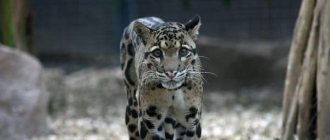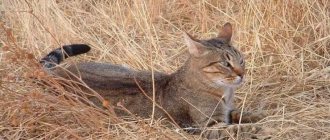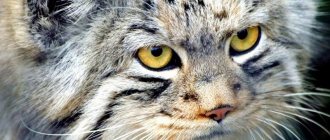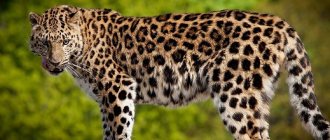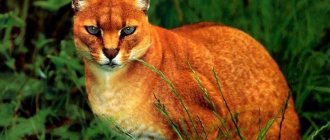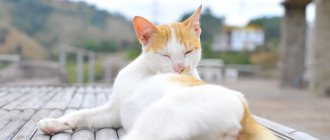Appearance characteristics
Solidity and impressiveness - these epithets perfectly describe the appearance of a nimble cat, which, it seems, will resemble a cute and fluffy kitten until old age. The Pampas cat breed has the following external features:
- The head is round in shape, massive and wide with a convex and expressive forehead.
- The nose is large in size, due to which it stands out well on the muzzle.
- The ears are triangular, high placed. A contrasting line runs along the edge of the fur of the ears.
- The eyes are of medium diameter, the pupils are located vertically.
- The body is up to 75 cm long, the weight of an adult is from 3 to 6 kg, males are heavier than females.
- The paws are muscular and quite short (when compared with other feline representatives), the feet are wide, and the claws are retractable.
- The tail is about 25 cm long.
- Wool – very dense, the length of the fibers is 7 cm. Depending on the habitat, the wool can have a different color.
Most representatives of the breed are gray in color with a brownish tint. In addition, there are individuals with a red tint to their fur; there are also Pampas cats whose fur has a rich black color, but this is most likely an exception to the rule.
The animal's muzzle is very cute, its mouth has a peculiar shape that resembles a smile. But such cuteness is very deceptive - the animal cannot stand communicating with strangers, showing with all its appearance that it will behave aggressively if its privacy is interfered with.
Behavior
Photo: Kilverstone Wildlife Park
Cats of this species are predominantly nocturnal. Wild individuals were observed to be active during the day. In addition, it should be noted that the male in the Zoological Park of Goania (Brazil) climbed trees well and spent most of his time resting on their tops. Very little is known about the social structure and connections of Pampas cats. When excited, in specimens living in captivity, a rise in hair along the midline from head to tail was observed.
Features of life in the wild and hunting
Representatives of the Pampas breed are distinguished by excellent auditory and visual characteristics.
Their vision reaches its maximum sharpness during the period of pitch darkness, when the animals go hunting. The cat is dexterous and flexible; it has no difficulty for her to climb the sloping branches of tall trees.
For shelter and rest, cats choose crevices in rocks, between tree roots rising above the ground, and also feel comfortable in bushes with high branches and lush leaves. Each individual has its own territory, which averages about 30 km2. The cat marks the occupied territory, irrigating the grass with drops of urine.
If a Pampas cat feels danger and a threat to its life, its fur begins to stand on end, the animal turns into a solid “ball” of hair. The cat prefers not to enter into open confrontation with enemies, so in moments of greatest danger he sits out on a tall tree. If there are no high branches nearby, the cat is saved by the fact that it can run fast.
The animal hunts at any time of the day, but still prefers the night. Thanks to the excellent functioning of the visual organs, the cat easily tracks the victim by tracks and scent. The furry hunter overtakes the chosen victim with several large jumps, a couple of meters long. Unlike most cats, the Pampas breed does not waste time sitting on the victim for a long time, preferring to overtake it and knock it down, while latching its teeth into the neck.
If you watch a cat for a long time, you get the impression that it is clumsy and short-legged, and cannot seem to be an excellent hunter. But this particular breed is considered the best hunter among other medium-sized cats. The animal attacks its target so quickly and swiftly that it does not have time to understand anything.
Who is in the “enemy” camp
In the wild, the Pampas cat is afraid only of large birds, predators larger than itself, and humans. This predator has always been the target of poachers. This is due to the thick and beautiful fur of the animal, from which fur coats were made. Due to the fact that the breed was hunted for a long time, the species at one point was on the verge of complete extinction, the population size decreased so much.
Today the population of the Pampas breed numbers about 50,000 individuals. These data are highly generalized, since the animal leads a secretive lifestyle, which makes it difficult to observe it for a long time.
In 1987, it was prohibited by law to hunt Pampas cats for the purpose of extracting fur and selling it to private owners.
This law took effect, and the breed population was partially restored.
Inhabitant of the South American steppes
The priest Juan Ignacio Molina first spoke about the dwarf wild cat, which lives in the bushes on the rocky slopes of the Andes. He was forced to emigrate to Italy, where in 1782 he published a book about the plants and animals of his homeland, Essay on the Natural History of Chile. The scientist decided to name the inhabitant of the pampas “bell”, which means “mountain cat” in the language of the Araucan Indians. This name was borne by the brave leader of the local tribe, who died in 1515 in a battle with the Spanish conquerors. In modern classification, the tiny furry predator has the Latin designation Leopardus colocolo and belongs to the subfamily of small cats (Felidae). American zoologists classify this species of animal in the genus Oncifelis, which sometimes causes confusion in the name of the wild cat.
The Pampas cat is found in most countries in South America. The stony plains fur trade flourished until 1987. At the same time, the last authorized batch of skins in the amount of 10 thousand pieces was sold. This measure saved the species from complete extermination. The furry animal is included in the International Red Book as endangered. The population of the small predator is stable only in Argentina, where its original habitats are protected in 9 nature reserves. In the biological parks of Peru and Brazil, steppe cats are very rare, and in Uruguay their presence has not been recorded for 10 years.
Nutrition
The diet of the Pampas cat consists of small rodents and small birds. If the hunt for rodents was unsuccessful, or the cat wanted to treat itself to a new menu, then they do not hesitate to feast on insects and non-poisonous reptiles.
The Pampas breed is quite neutral towards people with whom it often lives close. But people don’t like being around furry predators. The reason for this is that the cat preys on poultry, often destroying farmland.
Find out what other breeds of wild cats exist:
- black-footed cat;
- manul;
- dune cat
Felis colocolo
This animal, which lives in the southern regions of South America, both in appearance and coloring, resembles the well-known Felis silvestris, the European wild cat, and especially the Asian steppe cats, as well as the related Gobi cat. Like the latter, the Pampas cat, a resident of the South American grassy steppes, has noticeably enlarged auditory organs.
Although the Pampas cat itself is no larger than domestic cats (of the total length of 0.75 - 1.00 m, a third is the tail), its head, like all other South American small cats, is large, wide, with pointed ears. There are no tassels on the ears. The iris is brownish-yellow, the pupils are oval.
Among small felides, the Pampas cat stands out for its long hair, and a real mane grows along its spine. The length of the coat here reaches 7 cm. The main color varies greatly, because six varieties of the Pampas cat are known. Its northwestern representatives, living near the Andes, as well as those found near the southern border of the range, are painted in silver-gray and light gray tones. In Northern Argentina, lightish and yellowish-white individuals were observed, in which brown and gray tones were not visible. The inhabitants of tropical lowlands are distinguished by a rich brown color. In other areas, taupe and gray-yellow predominate.
Pampas cats living in the north of their range have ears that are black on the outside and have a white-gray spot in the middle; their southern relatives do not have a light spot, their ears are completely dark gray. The tail is thick, fluffy, with reddish-brown rings. On the upper part of the body there is a light reddish-brown pattern, with dark or black markings scattered across the body below.
The further you go to the south, the paler the pattern: among the inhabitants of Patagonia and southern Chile it is only barely outlined. It seems that such animals have no pattern at all. All varieties of the Pampas cat live in the grassy South American steppe, the pampas, in the territory from Ecuador to Patagonia; There are few or no trees here. Therefore, the Pampas cat hunts on the ground: rodents and birds nesting here. If they are nearby, they climb trees only in moments of danger.
Little is known about the breeding of Pampas cats. You rarely see them in zoos in Europe. Pampas cats are considered difficult to tame.
Best articles: What is a strait called in geography? Definition, examples and types
Continuation of the family line
Pampas cats are typical solitary cats of the wild. They live exclusively solitary lives; females and males unite only during the mating period. After mating, the male leaves the female, and they no longer see each other. All care for the offspring is entrusted to the female, who first feeds the cubs with milk, and then begins to accustom them to food of animal origin and teach them hunting skills.
Pregnancy lasts for a long time, about 3 months. Kittens in a litter are large in size, which is why only 1-2 of them are born. In extremely rare cases, a litter consists of 3 kittens. Kittens need the constant presence of their mother until they are 6 months old.
Recommendations
- ^ a b c d
Kitchener, A.K., Breitenmoser-Wursten, K., Eizirik, E., Gentry, A., Werdelin, L., Wilting, A., Yamaguchi, N., Abramov, A.V. , Christiansen, P., Driscoll, K., Duckworth, J.W., Johnson, W., Luo, S.-J., Majard, E., O'Donoghue, P., Sanderson, J., Seymour, K., Bruford, M., Groves, K., Hoffmann, M., Nowell, K., Timmons, Z., & Tobe, S. (2017).
"Revised Taxonomy of Felids: Final Report of the Cat Classification Working Group of the IUCN Felid Specialist Group" (PDF). Cat News
(Special Issue 11).CS1 maint: uses the authors parameter (link) - ^ a b c d f f
Lucerini, M.;
Eizirik, E.; de Oliveira, T.; Pereira, J.; Williams, R.S.R. (2016). " Leopard bell
."
IUCN Red List of Threatened Species
.
2016
: e.T15309A97204446. Retrieved January 13, 2022. - Novak, R. M. (1999). Mammals of Walker's World
. Volume 1 (Sixth ed.). Baltimore: Johns Hopkins University Press. ISBN 0-8018-5789-9. - ^ a b c d f g gram h i j k l m p o
Garcia-Perea, R. (1994).
"The Pampas Cat Group (Genus Lynchailurus
Severertsov 1858) (Carnivora: Felidae): A Systematic and Biogeographical Review" (PDF).
American Novitates Museum
(3096): 1–35. - ^ a b c
Wozencraft, W. C. (2005).
"Order of Predators" In Wilson, D.; Reeder, D.M. (ed.). Mammal Species of the World: A Taxonomic and Geographical Guide
(3rd ed.). Johns Hopkins University Press. pp. 538–539. ISBN 978-0-8018-8221-0. OCLC 62265494. - ^ a b
Johnson, W. E.;
Slattery, J.P.; Eizirik, E.; Kim, J. H.; Menotti Raymond, M.; Bonacic, C.; Cambre, R.; Crawshaw, P.; Nunes, A.; Seuánez, H.N.; Martins Moreira, M. A. (1999). "Disparate phylogeographic patterns of molecular genetic variation in four closely related South American small cat species." Molecular Ecology
.
8
(12 Suppl. 1):S79–94. doi:10.1046/j.1365-294x.1999.00796.x. PMID 10703553. S2CID 34990824. - ^ a b
Macdonald, D.;
Loveridge, A., ed. (2010). Biology and Conservation of Wild Felids
. Oxford: Oxford University Press. ISBN 978-0-19-923445-5. - ^ a b c d f g M.E
.;
Sunquist, F. C. (2009). "Bell ( Leopard bell
)."
In Wilson, D. E.; Mittermeier, R. A. (ed.). Handbook of the World's Mammals, Vol.
1 . Barcelona: Lynx Ediciones. paragraph 146. ISBN 978-84-96553-49-1. - ^ a b
Nascimento, FOD.;
Cheng, J.; Feijo, A. (2020). "Taxonomic revision of the pampas cat Leopard bell
complex (Carnivora: Felidae): an integrative approach."
Zoological Journal of the Linnean Society
: zlaa043. Doi:10.1093/zoolinnean/zlaa043. - ^ a b
Molina, G. I. (1782).
"La Guigna Felis Guigna
".
Saggio sulla storia naturale del Chilli
. Bologna: Stamperia di S. Tommaso d'Aquino. paragraph 295. - Cope E. D. (1889). "On mammals obtained by an expedition of naturalists to the south of Brazil." American naturalist
.
23
(266): 128–150. Doi:10.1086/274871. - ^ a b
Barstow, A. L., Leslie, D. M. (2012).
" Leopardus braccatus
(Carnivora: Felidae)."
Species of mammals
.
44
(1): 16–25. Doi:10.1644/891.1. - Matches P. (1912). "Uber Felis jacobita
,
Bells
, und zwei ihnen ähnliche Katzen" (PDF).
Sitzungsberichte der Gesellschaft Naturforschender Freunde zu Berlin
.
4
: 255–259. - Perovic, P.; Walker, S., & Novaro, A. (2003). "New information on the endangered Andean mountain cat in northern Argentina" (PDF). Oryx
.
37
(3):374–377. Doi:10.1017/S0030605303000644. S2CID 86059693. - Garcia-Olaechea, A. and Hurtado, C. M. 2016. Conservation of pampas cats in northwestern Peru. Small Wild Cat Conservation News 2 Archived 2016-10-06 on the Wayback Machine: 18.
- ^ a b c
Sunquist, M.;
Sunquist, F. (2002). "Pampas cat Oncifelis colocolo
(Molina, 1782)."
Wild cats of the world
. Chicago: University of Chicago Press. pp.201–204. ISBN 0-226-77999-8. - Macdonald D., Loveridge A., eds. (2010). Biology and conservation of wild cats.
Oxford University Press. ISBN 978-0-19-923445-5 - "ARKIV". Archived from the original on 2018-01-08. Retrieved 2017-12-03.
Features of living in captivity
Pampas cats are outwardly quite cute and fluffy animals, so because of this appearance, one gets the misleading impression that they are very kind and affectionate. It is almost impossible to tame this wild hunter as a pet. However, some lovers of exotic breeds want to get a Pampas cat without fully realizing what awaits them.
Life in captivity, whether in a zoo, nursery, or private property, is accompanied by a difficult period of acclimatization for the animal. Being taken out of natural conditions, the animal experiences severe stress, which negatively affects its immune system and health.
At first, a cat that ends up in a zoo, even though all conditions will be created for it, behaves with increased aggression and is constantly nervous.
In captivity, an animal does not produce offspring, and if an adult individual has been deprived of its natural habitat, it will not be possible to change its behavior and accustom it to life in new conditions.
If you want to get a Pampas cat, you need to equip a large enclosure for him outside. Representatives of this breed are completely unsuitable for living in an apartment, only in a private house with a large local area. Food – fresh, lean meat, fish. Industrial feeds are excluded from the animal’s diet.
If you decide to have this breed of cat as a pet, you should understand that you won’t be able to play with it. An animal, no matter how comfortable living conditions are created for it, will never abandon its wild habits and will not make contact with humans, remaining only a furry resident of an enclosure with an unkind and nervous character.
Pampas cats who were forced into captive conditions at a tender age adapt more easily. But as they grow older, their natural instincts and savage character will manifest themselves more and more.
Mr. Cat recommends: description, characteristics, habitat of the Pampas cat
Leopardus pajeros is a small predatory feline that lives mostly in grassy plains found in Latin America. If we talk specifically about the Pampas cat, it lives in Ecuador, Peru, Bolivia, Argentina and Chilean Patagonia. If we speak in a broad sense and include L. pajeros, as L. colocolo and L. braccatus are often done, then Brazil, Paraguay, Uruguay, and Chile should be added to the range.
The classification of the Pampas cat is still not clear. Her story is very confusing. Repeatedly its types were divided and united again, which is why we actually talked about it now in a narrow and broad sense. Sometimes the Pampas cat is written about as colocolo (Bell), in particular on Wikipedia, sometimes three species are meant by it: colocolo (Bell), braccatus (Pantanal cat) and pajeros itself.
The second name of the beast is Grass Cat. Although occasionally the animal is found in bushes, woodlands, semi-deserts of Patagonia and in the Brazilian pantanal, located in the area of a swampy tectonic depression.
In 2016, the Pampas cat was temporarily recorded in the Sechura Desert and dry forest in northwestern Peru.
This predatory mammal has been studied very little, despite the fact that the species was discovered more than two centuries ago. The Pampas cat is a very secretive animal, trying not to show itself to anyone.
The animal has a small and dense body with short limbs and a massive head and steep forehead.
Powerful paws have wide pads and claws that retract completely into them.
The nose is wide and long, protruding strongly beyond the cheekbones. The wild large lobe is usually pinkish in color and may have a dark edge.
Small triangular ears are set high and trimmed with black fur.
The eyes are small but expressive, the pupil is vertical.
The fur is coarse and shaggy (up to 7-8 cm long) of grayish-yellowish shades; marks of brownish or straw tones are scattered across the main background. Along the spine, the fur puffs up even more, forming a kind of mane.
The tail is long and bushy with reddish ring lines.
The total length of the body is about 80 cm, the tail is 20-30 cm, the weight of the feline representative is from 7 to 12 kg. That is, the Grass Cat is only slightly larger than the average pet, with thicker fur on its tail. Shaggy fur outwardly increases the size of the animal, and it seems clumsy.
There are six color variants of Leopardus pajeros, but all animals have two longitudinal dark lines on the cheekbones:
- The main background is reddish or deep gray, the spots are rusty-brown on the sides, the upper part of the ears is darker and ends with black tips. There are four or five red ring markings on the tail. The stripes on the paws are dark brown, there are charcoal markings on the chest, and the abdominal area is whitish. It lives in central Chile, in subtropical xerophytic forests at an altitude of 1800 m above sea level.
- The northern Andes are home to Pampass cats with reddish-brown rosette-shaped spots with darker borders, numerous rings on the tail (the same color as the side spots) and very dark brown, almost black stripes on the legs with spots or stripes on the undersides. body parts.
- The next isomorph resembles the previous type, but the background color is paler, and the body markings, stripes on the hind legs and rings on the tail are paler and less distinct.
- Another color morph resembles the previous two types, but the background is overall grayish with distinct dark brown stripes on the legs and spots on the underparts, a straight tail (no distinct rings), and mostly indistinct dark lines on the sides.
- The next variety is almost entirely rusty brown with faint spots, solid stripes, a loose tail with a prominent black tip, and completely black legs.
- This subtype is similar to the previous one, but the background color is paler and more yellowish, with the side spots being browner and more distinct, the feet (only black on the soles), broken rings, and a narrow black tip on the tail.
Pampas cat
A small predator lives and hunts in the pampas, hiding among the tall grass from the heat of the day, but some subspecies are found in the Andes and at an altitude of about five thousand meters.
The high secrecy of the animal does not allow us to collect accurate knowledge about the current population, but, most likely, the number of Pampas cats is not under threat and numbers at least fifty thousand specimens. Nevertheless, at the end of the last century, the world community introduced restrictions on the hunting of these animals, since Leopardus pajeros is still being displaced by humans from its natural habitat, the food supply is declining and poachers are hunting.
Security status
Pampas cats are listed on Appendix II of the Convention on International Trade in Endangered Species (CITES), meaning that trade in this species must now be strictly controlled. Hunting Pampas cats is strictly prohibited in Argentina, Bolivia, Chile and Paraguay, and regulated in Peru, but legislation does not protect these animals in Brazil and Ecuador. Conservation activities include identifying species and conducting research into the behavior, ecology, and distribution of animals.

